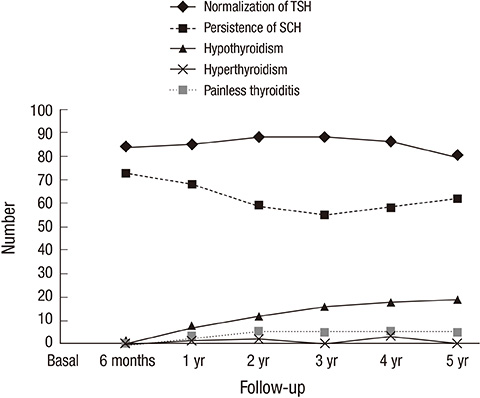J Korean Med Sci.
2013 Nov;28(11):1622-1626. 10.3346/jkms.2013.28.11.1622.
Prospective Observation of 5-Year Clinical Course of Subclinical Hypothyroidism in Korean Population
- Affiliations
-
- 1Department of Internal Medicine, Chungbuk National University School of Medicine, Cheongju, Korea. endoann@daum.net
- KMID: 1777659
- DOI: http://doi.org/10.3346/jkms.2013.28.11.1622
Abstract
- Subclinical hypothyroidism (SCH) is a common clinical condition, whereas it's natural course has not been identified distinctly. We evaluated the natural history of 169 SCH patients over 5-yr and the prognostic factors including thyroid autoantibodies and thyroid ultrasonographic (USG) findings related to develop overt hypothyroidism. After 5 yr, 47.3% of patients showed normalization of TSH, while 36.7% of patients remained persistence of high level of TSH, and overt hypothyroidism developed in 11.2% of patients. There were painless thyroiditis (2.9%) and hyperthyroidism (1.7%) during 5 yr follow-up. The thyroid nodule was seen in 48.6% of patients. Most of patients had 1 to 2 nodules whereas only 3% of patients with thyroid nodule had more than 6 nodules. Overt hypothyroidism patients had more heterogenous echogenecity in USG compared to patients with normalization or persistent SCH (76.5% vs 50.0% vs 35.0%, P = 0.048) and higher prevalence positive anti-thyroid peroxidase (anti-TPO Ab) and anti-thyroglobulin antibody (anti-Tg Ab) and titer of anti-TPO Ab than other two groups. The cut off values for prediction of overt hypothyroidism were TSH > 7.45 microIU/mL, free T4 < 1.09 ng/dL and Anti-TPO Ab > 560 IU/mL. SCH has various courses and initial TSH, free T4, presence of thyroid autoantibody, titer of thyroid autoantibody; and thyroid USG findings can serve as a prognostic factor for progression of overt hypothyroidism. These parameters suggest consideration to initiate thyroid hormone treatment in SCH.
MeSH Terms
-
Asymptomatic Diseases/*epidemiology
Autoantibodies/blood/immunology
Disease Progression
Female
Humans
Hyperthyroidism/epidemiology
Hypothyroidism/*epidemiology
Male
Middle Aged
Prevalence
Prospective Studies
Republic of Korea/epidemiology
Thyroglobulin/immunology
Thyroid Function Tests
Thyroid Gland/immunology
Thyroid Nodule/epidemiology
Thyroiditis/epidemiology
Thyrotropin/*blood
Autoantibodies
Thyroglobulin
Thyrotropin
Figure
Reference
-
1. Cooper DS. Clinical practice: subclinical hypothyroidism. N Engl J Med. 2001; 345:260–265.2. Kang HC. Selective therapy of subclinical hypothyroidism. J Korean Thyroid Assoc. 2009; 2:93–97.3. Canaris GJ, Manowitz NR, Mayor G, Ridgway EC. The Colorado thyroid disease prevalence study. Arch Intern Med. 2000; 160:526–534.4. Hak AE, Pols HA, Visser TJ, Drexhage HA, Hofman A, Witteman JC. Subclinical hypothyroidism is an independent risk factor for atherosclerosis and myocardial infarction in elderly women: the Rotterdam Study. Ann Intern Med. 2000; 132:270–278.5. Rodondi N, Newman AB, Vittinghoff E, de Rekeneire N, Satterfield S, Harris TB, Bauer DC. Subclinical hypothyroidism and the risk of heart failure, other cardiovascular events, and death. Arch Intern Med. 2005; 165:2460–2466.6. Biondi B, Cooper DS. The clinical significance of subclinical thyroid dysfunction. Endocr Rev. 2008; 29:76–131.7. Samuels MH, Schuff KG, Carlson NE, Carello P, Janowsky JS. Health status, mood, and cognition in experimentally induced subclinical hypothyroidism. J Clin Endocrinol Metab. 2007; 92:2545–2551.8. Roberts LM, Pattison H, Roalfe A, Franklyn J, Wilson S, Hobbs FD, Parle JV. Is subclinical thyroid dysfunction in the elderly associated with depression or cognitive dysfunction? Ann Intern Med. 2006; 145:573–581.9. Surks MI, Ortiz E, Daniels GH, Sawin CT, Col NF, Cobin RH, Franklyn JA, Hershman JM, Burman KD, Denke MA, et al. Subclinical thyroid disease: scientific review and guidelines for diagnosis and management. JAMA. 2004; 291:228–238.10. McDermott MT, Ridgway EC. Subclinical hypothyroidism is mild thyroid failure and should be treated. J Clin Endocrinol Metab. 2001; 86:4585–4590.11. Danese MD, Ladenson PW, Meinert CL, Powe NR. Clinical review 115: effect of thyroxine therapy on serum lipoproteins in patients with mild thyroid failure: a quantitative review of the literature. J Clin Endocrinol Metab. 2000; 85:2993–3001.12. Cooper DS, Halpern R, Wood LC, Levin AA, Ridgway EC. L-Thyroxine therapy in subclinical hypothyroidism: a double-blind, placebo-controlled trial. Ann Intern Med. 1984; 101:18–24.13. Nyström E, Caidahl K, Fager G, Wikkelsö C, Lundberg PA, Lindstedt G. A double-blind cross-over 12-month study of L-thyroxine treatment of women with 'subclinical' hypothyroidism. Clin Endocrinol (Oxf). 1988; 29:63–75.14. Razvi S, Ingoe L, Keeka G, Oates C, McMillan C, Weaver JU. The beneficial effect of L-thyroxine on cardiovascular risk factors, endothelial function, and quality of life in subclinical hypothyroidism: randomized, crossover trial. J Clin Endocrinol Metab. 2007; 92:1715–1723.15. Huber G, Staub JJ, Meier C, Mitrache C, Guglielmetti M, Huber P, Braverman LE. Prospective study of the spontaneous course of subclinical hypothyroidism: prognostic value of thyrotropin, thyroid reserve, and thyroid antibodies. J Clin Endocrinol Metab. 2002; 87:3221–3226.16. Kabadi UM. 'Subclinical hypothyroidism': natural course of the syndrome during a prolonged follow-up study. Arch Intern Med. 1993; 153:957–961.17. Karlin NJ, Weintraub N, Chopra IJ. Current controversies in endocrinology: screening of asymptomatic elderly for subclinical hypothyroidism. J Am Med Dir Assoc. 2004; 5:333–336.18. Rosário PW, Bessa B, Valadão MM, Purisch S. Natural history of mild subclinical hypothyroidism: prognostic value of ultrasound. Thyroid. 2009; 19:9–12.19. Imaizumi M, Sera N, Ueki I, Horie I, Ando T, Usa T, Ichimaru S, Nakashima E, Hida A, Soda M, et al. Risk for progression to overt hypothyroidism in an elderly Japanese population with subclinical hypothyroidism. Thyroid. 2011; 21:1177–1182.20. Glinoer D, Riahi M, Grün JP, Kinthaert J. Risk of subclinical hypothyroidism in pregnant women with asymptomatic autoimmune thyroid disorders. J Clin Endocrinol Metab. 1994; 79:197–204.21. Shin DY, Kim EK, Lee EJ. Role of ultrasonography in outcome prediction in subclinical hypothyroid patients treated with levothyroxine. Endocr J. 2010; 57:15–22.22. Vejbjerg P, Knudsen N, Perrild H, Laurberg P, Pedersen IB, Rasmussen LB, Ovesen L, Jørgensen T. The association between hypoechogenicity or irregular echo pattern at thyroid ultrasonography and thyroid function in the general population. Eur J Endocrinol. 2006; 155:547–552.
- Full Text Links
- Actions
-
Cited
- CITED
-
- Close
- Share
- Similar articles
-
- Depression in Patients with Subclinical Hypothyroidism: A Systematic Review and Meta-Analysis
- Subclinical Thyroid Dysfunction in the Elderly
- Prevalence and Risk Factors of Subclinical Thyroid Disease
- Comparison of Common Carotid Artery Intima-Media Thickness between Subclinical Hypothyroidism and Euthyroidism
- Subclinical Hypothyroidism during Quetiapine Treatment: A Case Report


